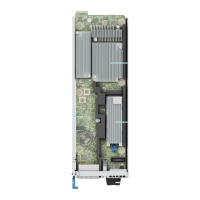Table 28. Supported memory matrix
DIMM type Rank Capacity DIMM rated voltage and speed DIMMs per Channel
(DPC)
RDIMM 1R 8 GB DDR4 (1.2V), 3200 MT/s 3200 MT/s
2R 16 GB / 32 GB / 64 GB DDR4 (1.2V), 3200 MT/s 3200 MT/s
General memory module installation guidelines
To ensure optimal performance of your system, observe the following general guidelines when configuring your system memory.
If your system's memory configurations fail to observe these guidelines, your system might not boot, stop responding during
memory configuration, or operate with reduced memory.
The memory bus may operate at speeds of 3200 MT/s, 2933 MT/s depending on the following factors:
● System profile selected (for example, Performance Optimized, or Custom [can be run at high speed or lower])
● Maximum supported DIMM speed of the processors
● Maximum supported speed of the DIMMs
NOTE: MT/s indicates DIMM speed in MegaTransfers per second.
The system supports Flexible Memory Configuration, enabling the system to be configured and run in any valid chipset
architectural configuration. The following are the recommended guidelines for installing memory modules:
● All DIMMs must be DDR4.
● x4 and x8 DRAM based memory modules can be mixed.
● If memory modules with different speeds are installed, they operate at the speed of the slowest installed memory module(s).
● Populate memory module sockets only if a processor is installed.
○ For single-processor systems, sockets A1 to A8 are available.
○ For dual-processor systems, sockets A1 to A8 and sockets B1 to B8 are available.
● In Optimizer Mode, the DRAM controllers operate independently in the 64-bit mode and provide optimized memory
performance.
Table 29. Memory population rules
Processor Configuration Memory population Memory population
information
Single processor Optimizer (Independent
channel) population order
A{1}, A{2}, A{3}, A{4}, A{5}, A{6},
A{7}, A{8}
1, 2, 4, 6 or 8 DIMMs are
allowed.
Dual processor (Start with
processor1. Processor 1
and processor 2 population
should match)
Optimizer (Independent
channel) population order
A{1}, B{1}, A{2}, B{2}, A{3}, B{3},
A{4}, B{4}, A{5}, B{5}, A{6}, B{6},
A{7}, B{7} A{8}, B{8}
2, 4, 8, 12 or 16 DIMMs are
supported per system
NOTE: Optimizer
population order is not
traditional for 8 and 16
DIMMs installations for
dual processor.
● Memory modules of different capacities can be mixed provided other memory population rules are followed.
● Mixing of more than two memory module capacities in a system is not supported.
● Unbalanced or odd memory configuration results in a performance loss and system may not identify the memory modules
being installed, so always populate memory channels identically with equal DIMMs for best performance.
● Supported RDIMM / LRDIMM configurations are 1, 2, 4, 6, 8 DIMMs per processor.
● Populate eight equal memory modules per processor (one DIMM per channel) at a time to maximize performance.
NOTE:
Equal memory modules refer to DIMMs with identical electrical specification and capacity that may be from
different vendors.
Installing and removing system components 59

